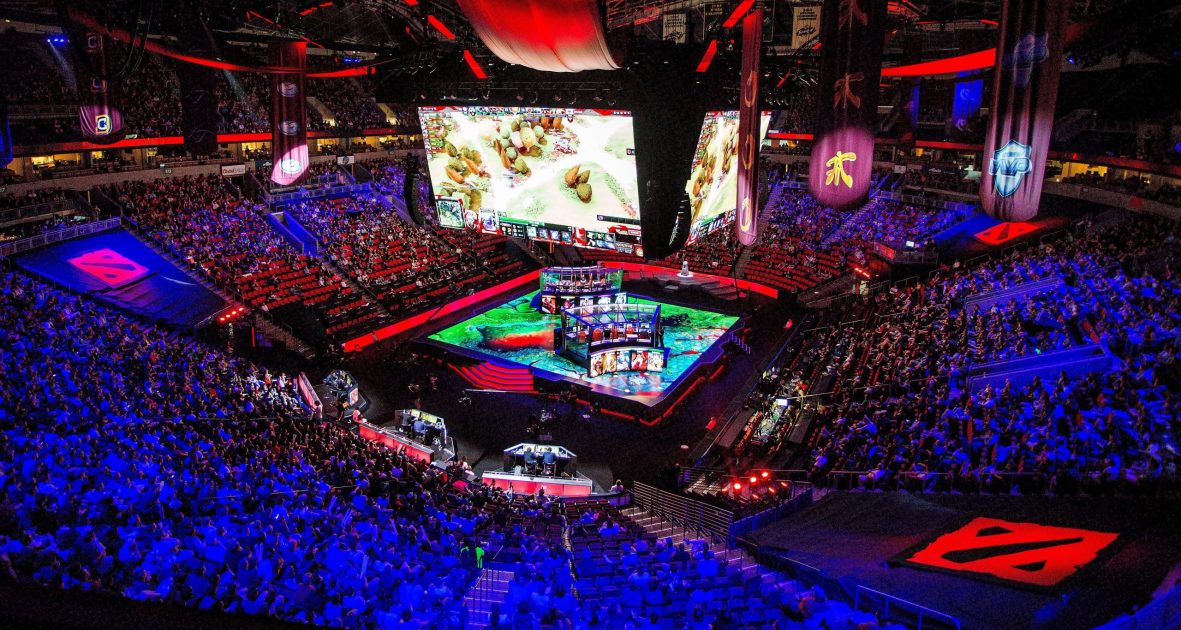For the sports enthusiasts, who love attending the stadiums, socializing, and chanting along with a super-energetic crowd, eSports first appeared as a dull idea limiting them to their homes. However, soon after the release of StarCraft: Blood War in 1999 in South Korea, all of that changed.
It helped the eSports industry transition towards mainstream success as professional teams of StarCraft received sponsorships from big companies like Samsung, Ongamenet along SK Telecom. Also, StarCraft tournaments were broadcasted to millions of television screens by MCBGame, which further catapulted the eSports industry towards global recognition.
After that, with groundbreaking tournaments like the ‘League of Legends World Championship’ of 2015 that hosted 43,000 spectators, more people started to show interest in eSports, especially after knowing about the handsome prize pools.
With each passing year, the eSports industry is witnessing exponential growth in revenue as well as viewers. However, these viewers are not the only source bringing big money to the industry.
So, in the following post, we will share the current growth rate of the eSports industry, revenue-generating factors, and the main reasons making this industry strong enough to compete with traditional sports.
The Growth of eSports Industry
Years before, eSports was taken simply as a subset for sports culture. But who knew that a revolutionary expansion would turn it out into a full industry? Today, not only the predictors are expecting a rise in the global audience to 474 million but are also estimating revenue of more than a billion dollars for 2021, shares a report published by Newzoo.
Both occasional and enthusiastic viewers of eSports started to grow in 2016 which thereby led to a 12.3% year over year rise between 2018 and 2019. Whereas for 2019 alone, the industry has a viewership of 198 million enthusiasts and 245 million casual viewers.
Moreover, the trend of games live-streaming has also increased alongside. In 2020, there was a 10.0% growth of global audience and for 2021, the viewer count is expected to rise to 728.8 million. Also, the pandemic is the accelerating factor behind live stream growth, which is predicted to expand until 2024.

China is the leading country for having the largest proportion of eSports enthusiasts (92.8 million) and a live streaming audience (193 million) for 2021. The country also stands first for bringing in the highest revenue of $360.1 million for the industry in 2021. North America with a revenue of $243.0 million and Western Europe with a revenue of $205.8 million are the following countries.
5 Reasons Why eSports is Flourishing
1. More People are Aware of eSports
One major reason behind eSports expansion is the rise in the number of people tending to learn about it. Back in 2015, Marketinghub shared that there were only 800,000 people aware of it.
But with each preceding year, the viewers stir up and there were around 1.43 billion people aware of eSports in 2018. Newzoo’s report speaks of the same facts and expected the global awareness to hit a total of 2.0 billion in 2020.
The rise of Covid-19 also worked in favor of the video gaming industry. With people locked inside their homes, eSports proved to be a source of entertainment for them. Record-breaking games like Call of Duty or Fortnite, and social media posts increased its popularity and somehow forced more people to learn about it.
Another factor is the inclination of celebrities and athletes toward eSports. In 2018, when Michael Jordan took part in eSport gaming with an investment of $26million, he strengthened the industry and attracted his fans toward it. After his retirement, the football star Ronaldo also got involved in the gaming industry and invested in CNB eSports club.

The Canadian rapper, Drake who is now a co-owner of ‘100 Thieves’, a company declared as the fifth most valuable eSport company by Forbes. And then there was Mike Tyson, whose interest was first drawn by his son which ultimately convinced him to join the founding team of Fade 2 Karma.
With these and many other new coming celebrities, the industry is welcoming millions of followers as their heartfelt audience.
2. There is Expansion of eSports Coverage
Now with a wider audience, reaching them all through a single platform was inadequate. Besides, unavailability could have diverted the interest of the viewers. Therefore, for a wide coverage of eSports, streaming platforms were developed and the game was made more accessible for the people worldwide.
Originated in 2011, Twitch is the pioneer of streaming platforms. The website gained popularity by just featuring broadcasts of esports and speedrunning. Later on, it was bought by Amazon and from then onwards, the platform has expanded a lot to add value for streamers.
According to Streamlabs, the majority of the streamers prefer Twitch over other platforms, and it has a market share of 91.1% for hours streamed. The stats from Twitchtracker also share that in 2020, 889 billion minutes were watched on the platform. Mixer’s shutdown and Covid emergence noted as the major reasons for this rise.

Following Twitch, other streaming platforms including YouTube gaming have emerged in recent times. The platform provides live streaming along with offering users the ease of searching gaming video content. YouTube gaming has also joined hands with ESL Pro League and other mobile esports including Clash Royale and has a market share of 5.5%.
The recently introduced Facebook gaming has already amassed exclusive broadcast rights and represents 3.4% of the market share. The platform provides users with live content according to the groups and pages they’ve liked.
Other than that, Steam Tv, Caffeine, Panda TV, and many other broadcasting platforms have made eSports more accessible and engaging, especially for a generation that is more interested in the digitization of traditional media.
3. The Watch Time for eSports has Increased
With raised awareness and accessibility, more people are interested in watching eSports as an alternative to traditional sports. Resultantly, the gaming industry is earning more by hosting viewers for longer hours.
Streamlab’s report includes stats regarding time spent watching eSports. During Q3 2020, more than 7.46 billion hours were watched globally through all streaming platforms. Whereas YouTube Gaming alone has seen a rise of 10.5% and 1.68 billion hours of content was watched in Q3 2020. This raises the platform’s market share to 22.5% for hours watching.
While Facebook Gaming was not left behind, and the platform successfully surpassed 1 billion hours of watch time. It now has a market share of 14% which is 1.4% higher than the figures recorded in the last quarter.
On the contrary, Twitch was not as fortunate as the other platforms and its watch time decreased from 5.12 billion to 4.74 billion in Q3. Nonetheless, the platform with 63.6% of market share is still on top of the list.

One more reason brought into light by the Limelight survey is that people who play video games tend to spend most of their time watching other gamers playing online instead of traditional sports. This is considered a gaming strategy to learn how professional gamers play and what are the latest tactics to beat competitors.
The study further tells that a considerable proportion of gamers take eSports as a viable career and around 50% of men between 18-25 years of age are planning to quit their jobs and pursue gaming as a profession.
Hence, this clearly signifies how crucial eSports is getting to become for both players and viewers. And it would not be wrong to say that eSport may overtake traditional sports sometime in the future.
4. Escalation of Brands Sponsoring eSports
It’s no wonder that brands always keep an eye out for customers and the platforms attracting more people toward them. With 2.7 billion gamers worldwide spending approximately 6.5 hours in playing, it goes without saying why the brands are curious about learning and investing more in the eSports industry.
Plus, the figures shared by AIB tells that 43% of eSports viewers earn $75,000 annually which denotes their spending power. Consequently, countless brands started to partner and sponsor both the games and gamers. And facilitating the marketing needs of brands has indirectly become a source of earning more revenue for the industry.

In 2019, more than $456 million were brought in by sponsorships, proving it to be the highest-grossing revenue stream for the eSports industry. PepsiCo is one of the pioneers to introduce this marketing strategy after they tied knots with the Rocket League Championship Series in 2017.
Later, Mastercard sponsored League of Legends and Mercedes-Benz partnered with ESL. Intel, a brand that was never seen interested in sports & games also stepped forward to sponsor Overwatch League.
On the other hand, there were a few brands that took the initiative of empowering the neglected sections of society through unique marketing strategies. The dating app Bumble partnered with Gen.G and formed an all-female team to compete in Fortnite. Lenovo created a team of Silver Snipers, the elderly citizens, and assisted them to compete in the gaming world.
Hence, until now, this all is turning in favor of the eSports industry as well as brands. With a sudden rise in sponsorships, there are possibilities that the brands will begin to uplift physical training sessions for gamers, sponsor giveaways, arrange live in-stream stunt games, etc. And the names like Pepsi, Coca-Cola, and Nike will likely become synonymous with eSports just like they are with traditional sporting games.
5. Expansion of eSports Tournaments
With millions of spectators and competitive gamers, what else you can expect other than the rise of eSports tournaments? Although with Covid-19, organizing large-scale tournaments were hindered, it is expected that the trend will continue to flourish in the post-pandemic world.
During 2018, 23,020 active players competed for 4579 tournaments and earned $164,829,763 in total, whereas $7,160 was calculated as the mean earnings of each player.
Moving forward, 2019 welcomed more players and attractive earnings for them. 27,279 players were participating in 5288 tournaments and earning 42% more than the previous year. $234,433,656 was the total revenue out of which each player received approximately $8,594.
However, 2020 was not as good as the past years especially for professional players. From 4228 tournaments held, each player had mean earnings of $5,030 only. 2021 with its barriers is again challenging the players and as of now, they have earned $30,135,047 in total.
ESport betting is one of the most prominent outcomes of the surge in tournaments. While corona affected the revenue stream for players, there was a significant rise in eSports betting, as reported by Forbes. Disruption of live events like football, basketball, tennis was considered the major reason for propping this sector of the sports gambling industry.

Compared to March 2019, when gross gambling yield for the industry was only $63,493, the year 2020 turned out to be a massive hit. In March 2020, the gross gambling yield rose to $1,918,541. Afterward, in May 2020, it was $5,835,764.
However, it is expected that with the resumption of other sports, eSport gambling will drop. But if a good number of gamblers choose to stick to it, eSport betting can be a profitable sector for the betting industry in the post-pandemic world.
ESports & the Future Market
While Covid-19 became a reason for engaging people in eSports gaming, making them continue watching and playing it in the post-pandemic world will be a bit different.

According to a report published by Deloitte, the franchised league games require each team to pay an excessive amount for participating. But before investing hefty sums, the investors would always seek to find the best teams to invest in.
Whereas with extensive revenue generation, the competition has also started to grow in the industry. So, for convincing brands, companies need to adopt new strategies that differentiate them from the competitors.
In brief, whether you are a platform offering eSports coverage or a team competing in the tournament, the revenue you will earn is dictated substantially by the audience market share. Because the brands will go with the names accumulating more people, how many viewers you have will ultimately decide your earnings.
And since a large proportion of eSports revenue is earned from sponsorships and advertisements, a company cannot afford to find another way for sustaining itself in the market except attracting brands.
The Way Forward
Investors are putting more and more money into the eSports industry and the prize pools for the events are becoming larger. As a result, this is motivating eSports enthusiasts around the globe to bring their A-game to the table and simultaneously, new people are also gaining interest in it.
Judging by the current trend at which eSports is growing – it’s safe to say that in the upcoming years it will only expand further.




